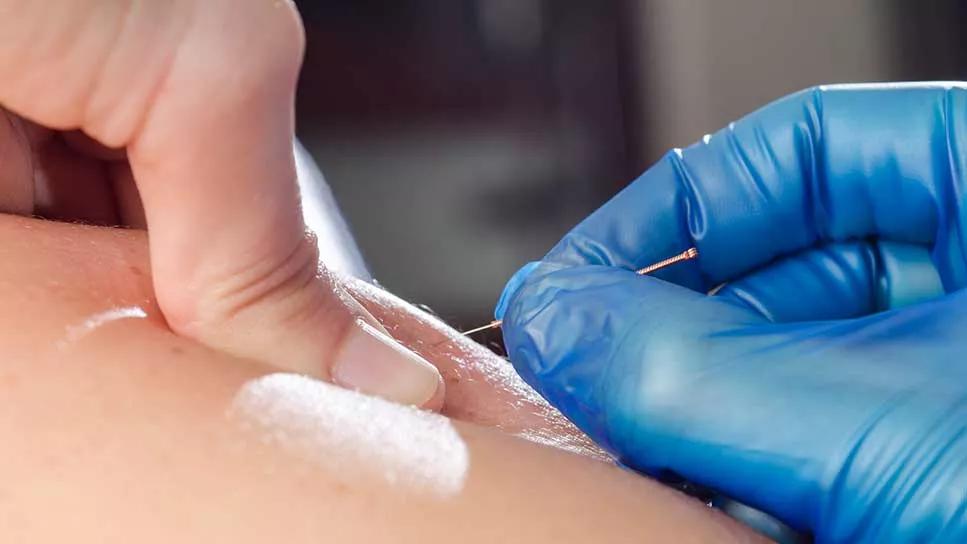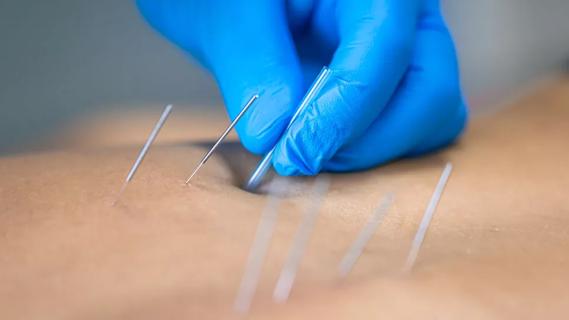As part of a larger treatment strategy, it can help decrease muscle tightness and reduce pain

A growing number of people, from athletes to people with injuries or chronic pain, swear by dry needling as a way to provide sweet relief for intense muscle pain and mobility issues.
Advertisement
Cleveland Clinic is a non-profit academic medical center. Advertising on our site helps support our mission. We do not endorse non-Cleveland Clinic products or services. Policy
Dry needling, also known as intramuscular stimulation, is a type of trigger point therapy that’s been used for decades — and it’s become an increasingly popular drug-free way to treat musculoskeletal pain.
But how does dry needling work and what can it do for you?
Dry needling is when a trained, licensed professional inserts thin, dry needles through the skin into the muscle tissue. “Dry,” in this case, means the needles don’t inject anything into the body (like, say, getting a shot).
It’s been shown to:
“Dry needling can play an important role in muscle recovery and pain relief,” says clinical rehabilitation manager Adam Kimberly, PT, DPT, OCS. “Our main focus is muscle and connective tissue and trying to restore mobility.”
Some people feel improvement in their pain and mobility almost immediately after a dry needling session. For others, it takes more than one session.
But to understand how dry needling provides this relief, you first need to understand what’s happening in your muscles.
When your muscles are overused or strained, they can develop knotted areas called myofascial trigger points. These areas can be irritable and painful, and they might limit your mobility.
Advertisement
“An overused muscle goes through an energy crisis, where its fibers aren’t getting enough adequate blood supply,” Dr. Kimberly explains. “Without a normal blood supply, the muscle doesn’t get the oxygen and nutrients it needs to be able to return to its normal resting state.
Instead, the tissue around the trigger point becomes more acidic and the nerves become more sensitized, which leads to all that soreness and pain you feel. But when a dry needle stimulates a trigger point, Dr. Kimberly says that it helps draw normal blood supply back to the area. This helps flush it out and ultimately releases tension.
The prick sensation can also fire off nerve fibers that stimulate your brain to release endorphins — hormones that act as your body’s own natural pain relievers.
Dry needling practitioners feel for trigger points with their hands. They may also use a trigger point map, which shows common areas on the body where trigger points are likely to develop.
Once they locate a trigger point, they insert a needle directly into it, through your skin.
“They might move the needle around a bit to try to prompt what’s called a local twitch response, which is a quick spasm of the muscle,” Dr. Kimberly explains. “This reaction is a sign that the muscle is reacting to the treatment.”
After a dry needling session, you may feel some soreness or tenderness for 24 to 48 hours.
“It’s important to continue to keep the affected muscles loose by continuing to move them within their new range of motion after treatment,” Dr. Kimberly adds.
Dry needling is considered very safe, with very little risk of complications. You might feel some stiffness, soreness or bruising at or around the area of your trigger points. In rare cases, you could experience bleeding or infection.
Dry needling and acupuncture may seem very similar — after all, they both involve inserting fine needles into your skin — but from a medical perspective, they’re actually quite different.
Acupuncture comes from traditional Chinese medicine and is about trying to balance your body’s energy flow, known as qi. Acupuncturists insert needles into “acupoints” that are thought to stimulate qi, which prompts your body to fight your illness or symptoms.
Dry needling, on the other hand, is a Western medicine treatment that targets the specific trigger points that are causing you pain or limiting your mobility. Like other physical therapy treatments, dry needling targets muscle dysfunction to relieve pain and tension.
Advertisement
The internet is full of misleading headlines that indicate that dry needling is illegal in some states — but don’t believe them! Dry needling is legal in all U.S. states and the District of Columbia. But where you live does dictate who is allowed, by law, to perform the treatment.
In most states, physical therapists perform dry needling. In a handful of states, though, dry needling must be performed by acupuncturists, and there are laws in place that actually prohibit physical therapists from doing it.
The American Physical Therapy Association keeps track of these laws and shares an infographic to help you understand the rules in your state.
Dry needling doesn’t usually stand alone as a treatment, but it can be a helpful component of a larger treatment strategy.
“It’s almost always used as part of a larger pain management plan that could include exercise, stretching, massage and other techniques,” Dr. Kimberly clarifies.
Your provider can advise you on whether dry needling could be a helpful addition to your treatment plan for muscle recovery, mobility issues, or acute or chronic pain.
“Needling is just a component of the therapy process,” Dr. Kimberly says. “It’s not everything, and it’s not the be-all, end-all for everyone.”
Advertisement
Learn more about our editorial process.
Advertisement

Both can help reduce pain, but they’re very different in terms of origins, philosophies and practices

This evidence-based practice is used to help manage pain, relieve menopause symptoms and boost your spirits

The causes of fibromyalgia are complex, but an overactive immune system might be part of it

These creams that you apply to your skin can actually help reduce localized pain, swelling and inflammation

Medical massage is tailored to your health needs to help you recover

Low-level, dull soreness that goes away with rest or physical activity is normal — but if it lingers or worsens, see a healthcare provider

Hydration, nutrition and athletic guidance can help, but so can massage, Epsom salt baths and more

When your lower back hurts, stretching and staying active can be key to finding relief

If you’re feeling short of breath, sleep can be tough — propping yourself up or sleeping on your side may help

If you fear the unknown or find yourself needing reassurance often, you may identify with this attachment style

If you’re looking to boost your gut health, it’s better to get fiber from whole foods